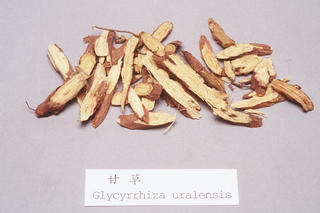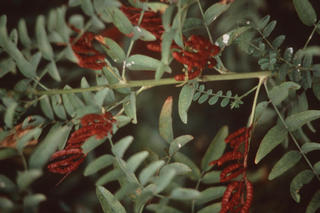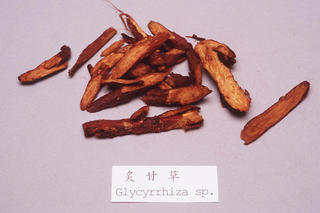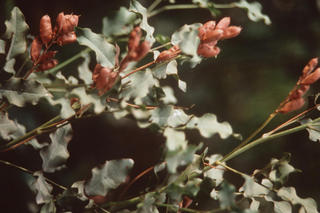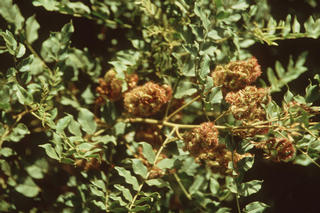Glycyrrhiza glabra
Contents
- 1 Nomenclature
- 2 Historical Use of Glycyrrhiza glabra
- 3 Background
- 4 Nomenclature
- 5 Historical Use of Glycyrrhiza glabra
- 6 Background
- 7 Nomenclature
- 8 Historical Use of Glycyrrhiza glabra
- 9 Background
- 10 Nomenclature
- 11 Historical Use of Glycyrrhiza glabra
- 12 Background
- 13 Pharmaceutical Information
- 14 Evidence or the Use of Glycyrrhiza glabra in the Treatment of Epilepesy
- 15 Safety
Nomenclature
Other Names:
Historical Use of Glycyrrhiza glabra
Glycyrrhiza glabra in Traditional Chinese Medicine
Background
Fengancao ·Û¸Ê²Ý
Gancaoshao ¸Ê²ÝÉÒ
Shenggancao Éú¸Ê²Ý
Zhigancao Ö˸ʲÝ
Chinese Name (pinyin): Gancao
Chinese Name :
Common Name :Liquorice
Specific Name : Radix glycyrrhizae
Scientific Name:
Collection : The drug is collected in spring and autumn, remove from rootlet and dried in the sun.
Description : Root of Glycyrrhizae uralensis: Roots cylindrical, 2 - 100 cm long, 0.6 - 3.5 cm in diameter. The outer bark loose or tight. Externally reddish brown or greyish brown, obviously longitudinally wrinkled furrowed, lenticellate with sparse rootlet scars. Texture compact, fracture slightly fibrous, yellowish white starchy, cambium ring distinct, rays radiate, some with clefts. Rhizomes cylindrical, externally with bud scars, pith present in the center of fracture. Odour slight, taste sweet and characteristic.Root of Glycyrrhizae inflata: Roots and rhizomes woody and stout, some branched, the outer bark rough, mostly greyish brown. Texture compact. More lignified fibres and less starchy. Rhizomes with more and large adventitious buds.Roots of Glycyrrhzae glabra: Texture of the root and rhizomes relatively compact, some branched, the outer bark not rough, mostly greyish brown, lenticels small and indistinct.
Identification : 1.Transverse section: Cork consisting of several layers of brown cells. Cortex relatively narrow. Phloem rays broad mostly curved, frequently with clefts, most phloem fibres in bundles, unlignified or slightly lignified. Surrounded by parenchymatous cells containing prisms of calcium oxalate, sieve tube tissue often press to be collapsed. Fascicular cambium distinct. Xylem rays 3- 5 cells wide, vessels frequent up to 160 µm in diameter, xylem fibres in bundles, surrounded by parenchymatous cells containing prisms of calcium oxalate. Roots without pith at the center, rhizomes processing pith at the center.Powder: Brownish yellow, fibres in bundles. 8 - 14 µm in diameter, thick walled, slightly lignified, surrounded by parenchymatous cells containing prisms of calcium oxalate forming crystal fibres. Prisms of calcium oxalate frequent. Bordered pitted vessels large, reticulated vessels rare. Cork cells reddish brown, polygonal, slightly lignified.3.To 1g of the powder add 40 ml of ether. Heat under reflux on a water bath for 1 hour, filter. Heat the residue under reflux in 30 ml of methanol on a water bath for 1 hour and filter. Evaporate the filtrate to dryness and dissolve the residue in 40 ml of water. Extract the aqueous solution with 3 quantities, each of 20 ml of n-butanol. Combine the n-butanol solution wash with water for 3 times and evaporate on a water bath to dryness. Dissolve the residue in 5 ml of methanol as the test solution. Prepare a solution of Radix Glycyrrhizae reference drug in the same manner as the reference drug solution. Dissolve ammonium glycyrrhizate CRS in methanol to produce a solution containing 2mg per ml as the reference solution. Carry out the method for thin layer chromatography (Appendix Vl B), using silica gel G containing 1% solution of sodium hydroxide as the coating substance and ethyl acetate-methanol-glacial acetic acid-water (30:2:2:4) as the mobile phase. Apply separately to the plate. 1 -2 µl of each of the three solutions. After developing and removal of the plate, dry it in the air. Spray with 10% solution of sulfuric acid in ethanol, heat at 105ºC to visualize clearly and examine under ultra violet light (365 nm). The fluorescent spot in the chromatogram obtained with the test solution correspond in position and colour to the spot in the chromatogram obtained with the reference drug solution. The orange yellow fluorescent spot in the chromatogram obtained with the test solution correspond in position and colour to the spot in the chromatogram obtained with the reference solution.Water: Carry out the method for determination of water (Appendix lX H, method 1) not more than 12.0%. Total ash: Not more than 7.0% (Appendix lX K)Acid insoluble ash: Not more than 2.0%
Processing : Eliminate foreign matter, wash clean, soften thoroughly, cut into thick slices and dry.
Action : To reinforce the function of the spleen and replenish qi, to remove heat and counteract toxicity, to dispel phlegm and relieve cough, to alleviate spasmodic pain, and to moderate drug actions. Radix Glycyrrhizae (processed with honey): To reinforce the fu
Indication : weakness of the spleen and the stomach marked by lassitude and weakness; cardiac palpitation and shortness of breath; cough with much phlegm; spasmodic pain in the epigastrium, abdomen and limbs; carbuncles and sores. Often used for reducing the toxic and drastic actions of other drugs
Precautions : Incompatible with Radix Euphorbiae Pekinensis, Flos Genkwa and Radix Kansui.
Dosage : 1.5 to 9 g.
Storage : Preserve in a ventilated and dry place, protected from moth.
Nomenclature
Other Names:
Historical Use of Glycyrrhiza glabra
Glycyrrhiza glabra in Traditional Chinese Medicine
Background
Chinese Name (pinyin): Zhigancao
Chinese Name :
Common Name :Liquorice Root (processed with honey)
Specific Name : Radix glycyrrhizae preparata
Scientific Name:
Collection : The drug is a processed Radix Glycyrrhizae.
Description : Procedure: Stir fry the slices of Radix Glycyrrhizae as described under the method for stir frying with honey (Appendix ll D) until it becomes yellow to deep yellow and not sticky to the fingers, take out and cool in the air.Description: Occurring in subrounded oe eliptical slices, externally reddish brown, slightly lustrous, cut surface yellow to deep yellow. Cambium ring distinct, rays radiate. Texture slightly sticky. Odour with agreeable burnt smelling, taste sweet.
Identification : Carry out the method as described under Identification test (2) in the monograph of Radix Glycyrrhizae, it shows the same result.Water: Carry out the method for determination of water (Appendix lX H, method 1) not more than 10.0%Total ash: Not more than 5.0% (Appendix lX K)Acid insoluble ash: Not more than 1.0%
Processing :
Action : To invigorate the function of spleen and stomach, to reinforce qi and promote blood circulation.
Indication :
Precautions :
Dosage : 1.5 to 9 g.
Storage : Incompatible with Radix Euphorbiae Pekinensis, Flos Genkwa and Radix Kansui.
Nomenclature
Other Names:
Historical Use of Glycyrrhiza glabra
Glycyrrhiza glabra in Traditional Chinese Medicine
Background
Fengancao ·Û¸Ê²Ý
Gancaoshao ¸Ê²ÝÉÒ
Shenggancao Éú¸Ê²Ý
Zhigancao Ö˸ʲÝ
Chinese Name (pinyin): Gancao
Chinese Name :
Common Name :Liquorice
Specific Name : Radix glycyrrhizae
Scientific Name:
Collection : The drug is collected in spring and autumn, remove from rootlet and dried in the sun.
Description : Root of Glycyrrhizae uralensis: Roots cylindrical, 2 - 100 cm long, 0.6 - 3.5 cm in diameter. The outer bark loose or tight. Externally reddish brown or greyish brown, obviously longitudinally wrinkled furrowed, lenticellate with sparse rootlet scars. Texture compact, fracture slightly fibrous, yellowish white starchy, cambium ring distinct, rays radiate, some with clefts. Rhizomes cylindrical, externally with bud scars, pith present in the center of fracture. Odour slight, taste sweet and characteristic.Root of Glycyrrhizae inflata: Roots and rhizomes woody and stout, some branched, the outer bark rough, mostly greyish brown. Texture compact. More lignified fibres and less starchy. Rhizomes with more and large adventitious buds.Roots of Glycyrrhzae glabra: Texture of the root and rhizomes relatively compact, some branched, the outer bark not rough, mostly greyish brown, lenticels small and indistinct.
Identification : 1.Transverse section: Cork consisting of several layers of brown cells. Cortex relatively narrow. Phloem rays broad mostly curved, frequently with clefts, most phloem fibres in bundles, unlignified or slightly lignified. Surrounded by parenchymatous cells containing prisms of calcium oxalate, sieve tube tissue often press to be collapsed. Fascicular cambium distinct. Xylem rays 3- 5 cells wide, vessels frequent up to 160 µm in diameter, xylem fibres in bundles, surrounded by parenchymatous cells containing prisms of calcium oxalate. Roots without pith at the center, rhizomes processing pith at the center.Powder: Brownish yellow, fibres in bundles. 8 - 14 µm in diameter, thick walled, slightly lignified, surrounded by parenchymatous cells containing prisms of calcium oxalate forming crystal fibres. Prisms of calcium oxalate frequent. Bordered pitted vessels large, reticulated vessels rare. Cork cells reddish brown, polygonal, slightly lignified.3.To 1g of the powder add 40 ml of ether. Heat under reflux on a water bath for 1 hour, filter. Heat the residue under reflux in 30 ml of methanol on a water bath for 1 hour and filter. Evaporate the filtrate to dryness and dissolve the residue in 40 ml of water. Extract the aqueous solution with 3 quantities, each of 20 ml of n-butanol. Combine the n-butanol solution wash with water for 3 times and evaporate on a water bath to dryness. Dissolve the residue in 5 ml of methanol as the test solution. Prepare a solution of Radix Glycyrrhizae reference drug in the same manner as the reference drug solution. Dissolve ammonium glycyrrhizate CRS in methanol to produce a solution containing 2mg per ml as the reference solution. Carry out the method for thin layer chromatography (Appendix Vl B), using silica gel G containing 1% solution of sodium hydroxide as the coating substance and ethyl acetate-methanol-glacial acetic acid-water (30:2:2:4) as the mobile phase. Apply separately to the plate. 1 -2 µl of each of the three solutions. After developing and removal of the plate, dry it in the air. Spray with 10% solution of sulfuric acid in ethanol, heat at 105ºC to visualize clearly and examine under ultra violet light (365 nm). The fluorescent spot in the chromatogram obtained with the test solution correspond in position and colour to the spot in the chromatogram obtained with the reference drug solution. The orange yellow fluorescent spot in the chromatogram obtained with the test solution correspond in position and colour to the spot in the chromatogram obtained with the reference solution.Water: Carry out the method for determination of water (Appendix lX H, method 1) not more than 12.0%. Total ash: Not more than 7.0% (Appendix lX K)Acid insoluble ash: Not more than 2.0%
Processing : Eliminate foreign matter, wash clean, soften thoroughly, cut into thick slices and dry.
Action : To reinforce the function of the spleen and replenish qi, to remove heat and counteract toxicity, to dispel phlegm and relieve cough, to alleviate spasmodic pain, and to moderate drug actions. Radix Glycyrrhizae (processed with honey): To reinforce the fu
Indication : weakness of the spleen and the stomach marked by lassitude and weakness; cardiac palpitation and shortness of breath; cough with much phlegm; spasmodic pain in the epigastrium, abdomen and limbs; carbuncles and sores. Often used for reducing the toxic and drastic actions of other drugs
Precautions : Incompatible with Radix Euphorbiae Pekinensis, Flos Genkwa and Radix Kansui.
Dosage : 1.5 to 9 g.
Storage : Preserve in a ventilated and dry place, protected from moth.
Nomenclature
Other Names:
Historical Use of Glycyrrhiza glabra
Glycyrrhiza glabra in Traditional Chinese Medicine
Background
Chinese Name (pinyin): Zhigancao
Chinese Name :
Common Name :Liquorice Root (processed with honey)
Specific Name : Radix glycyrrhizae preparata
Scientific Name:
Collection : The drug is a processed Radix Glycyrrhizae.
Description : Procedure: Stir fry the slices of Radix Glycyrrhizae as described under the method for stir frying with honey (Appendix ll D) until it becomes yellow to deep yellow and not sticky to the fingers, take out and cool in the air.Description: Occurring in subrounded oe eliptical slices, externally reddish brown, slightly lustrous, cut surface yellow to deep yellow. Cambium ring distinct, rays radiate. Texture slightly sticky. Odour with agreeable burnt smelling, taste sweet.
Identification : Carry out the method as described under Identification test (2) in the monograph of Radix Glycyrrhizae, it shows the same result.Water: Carry out the method for determination of water (Appendix lX H, method 1) not more than 10.0%Total ash: Not more than 5.0% (Appendix lX K)Acid insoluble ash: Not more than 1.0%
Processing :
Action : To invigorate the function of spleen and stomach, to reinforce qi and promote blood circulation.
Indication :
Precautions :
Dosage : 1.5 to 9 g.
Storage : Incompatible with Radix Euphorbiae Pekinensis, Flos Genkwa and Radix Kansui.
Synonymns for Glycyrrhiza glabra
Patent Medicines and Medicines with Multiple Ingredients that include Glycyrrhiza glabra
Pharmaceutical Information
Chemical Constituents
Evidence or the Use of Glycyrrhiza glabra in the Treatment of Epilepesy
Basic Science
Animal Studies
Cohort, Case-Control and Non-Randomized Trials
Randomized Controlled Trials
Meta-Analysis
1st Five Results: pubmed search
Zhanchao Xu, Qiuxian Bai, Xueying Peng, Duoyong Lang, Xinhui Zhang
##Title##
J Agric Food Chem: 2024;
[PubMed:38661009]
[WorldCat.org]
[DOI]
(I a)
Junze Jiang, Xintong Zhou, Hao Chen, Xin Wang, Yongbao Ruan, Xiaohui Liu, Jun Ma
18β-Glycyrrhetinic acid protects against deoxynivalenol-induced liver injury via modulating ferritinophagy and mitochondrial quality control.
J Hazard Mater: 2024, 471;134319
[PubMed:38657511]
[WorldCat.org]
[DOI]
(I a)
Juncang Peng, Yaling Fan, Yuping He, Yao Wang, Yaqing Zhu, Yu Fu, Yonglin Shang, Jia Yu
Quality evaluation of natural monomer flavors for Chinese tobacco industry based on dual mode combined Fourier transform ion cyclotron resonance mass spectrometry and isotopic fine structures.
Rapid Commun Mass Spectrom: 2024, 38(13);e9748
[PubMed:38644558]
[WorldCat.org]
[DOI]
(I p)
Gan Gu, Xuwen Hou, Mengyao Xue, Xiaowei Jia, Xiaoqian Pan, Dan Xu, Jungui Dai, Daowan Lai, Ligang Zhou
Rosellichalasins A-H, cytotoxic cytochalasans from the endophytic fungus Rosellinia sp. Glinf021.
Phytochemistry: 2024;114103
[PubMed:38636686]
[WorldCat.org]
[DOI]
(I a)
Sawsan S Elbasuni, Hanan A A Taie, Samah M Abdel Gawad, Reda E L Kamar, Hala El Daous, Marwa Darweish, Mai O Nada, Walaa F SaadEldin, Marwa I Abdel Haleem
##Title##
Open Vet J: 2024, 14(1);225-241
[PubMed:38633172]
[WorldCat.org]
[DOI]
(I p)
